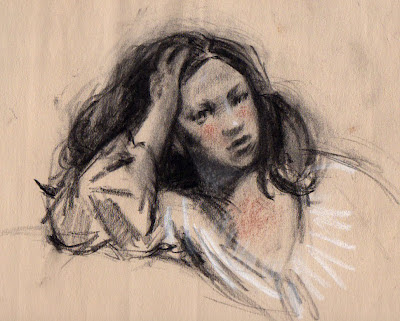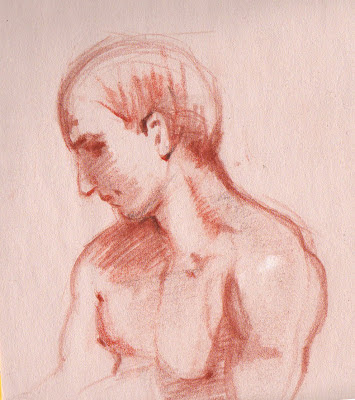Thursday, February 28, 2013
Ninety
Study (after Sherrie McGraw). I find it amazing to watch both Sherrie McGraw and Rob Liberace draw. They both use a very light touch. I'm naturally heavy handed and have had to learn to lighten up. I struggle to believe that less is more.
With a light touch the soul can rise to the surface. -Hugh Milne, "The Heart of Listening"
Wednesday, February 27, 2013
Ninety-One
Study (after Sherrie McGraw). When you're struggling, stepping away can help you see. Maybe the neck is too short. But it might not be that the neck is too short, it could be that the ear is too low, the chin too long, or that back of the skull does not go out far enough.
Tension in the shoulders might be coming from unstable hips, a clenched jaw, the inability to expand the ribs to take a full breath, or difficulty finding the feet on the ground in order to truly be here. And it's when you look too hard that you can't see it.
Tension in the shoulders might be coming from unstable hips, a clenched jaw, the inability to expand the ribs to take a full breath, or difficulty finding the feet on the ground in order to truly be here. And it's when you look too hard that you can't see it.
Tuesday, February 26, 2013
Ninety-Two
Study (after Sherrie McGraw). I love this model. He looks very Taos to me and that would make sense because that's where Sherrie lives. I notice when I get lost in a drawing, instead of backing away, I will get hawkish and keep darkening the dark parts, tracing again and again over the contours that are already there.
The tendency, when you are lost, is to hammer away at what you already know, hoping that if you keep trodding the same path it will somehow lead you to a new place. But it's too much focus that makes it so you can't see.
Monday, February 25, 2013
Ninety-Three
Study (after Sherrie McGraw). It was with this drawing that I realized I really need to invest in some better paper. I've been doing these on newsprint and and there's a point where the materials turn to mush and you can't go either lighter or darker. And if you keep pushing it the paper falls apart. Although there are details I'm not happy with in this drawing, I do like the overall mood it captured.
But, it reminds me of my original intent, to not just copy but to understand.
Friday, February 22, 2013
Ninety-Four
Study (after Sherrie McGraw). I love this, from "The Heart of Listening" a book about craniosacral by Hugh Milne.
In old Persia, a shaman and his apprentice are walking in the dusty foothills. Rounding the flank of the hillside, they see in the distance the stooped figure of an old man coming toward them. The apprentice, having studied hard with the shaman for ten years, is eager to show his skills. He bounds ahead of the shaman and runs up to the old man. "Sir, I know what's wrong with you, I know, and what you need for what ails you is pomegranates!" The old man brushes him aside, irritated. He looks exhausted and despondent. Soon he reaches the shaman, who says, "Kind sir, you look tired. Pray stop awhile and share some tea -my eager apprentice here will gather us some kindling, and we can make a refreshment." The old man readily agrees to this warm offer.
It takes an hour to light the fire, unpack the kettle, suffuse mountain water from a spring half a mile away with tea chipped off his tea brick. Holding his own counsel, the shaman by his very silence, allows the old man to speak. It begins backward: where he is going today, which touches on his wife who died, to their wedding, to his father's farmhouse in spring. He tells his life story.
By the time they are packing up, ready to leave, the shaman turns to the old man and, in a soft, kindly voice, asks his permission to make a suggestion regarding his health. The shaman makes a deft, calming gesture with his hands; it is like a little ritual. The old man gratefully agrees.
"Sir, what you need for what ails you is pomegranates," says the shaman. The old man bows in gratitude, and gives the shaman three silver coins from his woven purse. He walks off, a different lift to his walk.
As soon as the old man is out of earshot, the apprentice, no longer able to contain himself, speaks up: "But I told him that. I told him that immediately!" "Yes," answered the shaman, "you were right, he did need pomegranates. But he needed pomegranates, and time."
In old Persia, a shaman and his apprentice are walking in the dusty foothills. Rounding the flank of the hillside, they see in the distance the stooped figure of an old man coming toward them. The apprentice, having studied hard with the shaman for ten years, is eager to show his skills. He bounds ahead of the shaman and runs up to the old man. "Sir, I know what's wrong with you, I know, and what you need for what ails you is pomegranates!" The old man brushes him aside, irritated. He looks exhausted and despondent. Soon he reaches the shaman, who says, "Kind sir, you look tired. Pray stop awhile and share some tea -my eager apprentice here will gather us some kindling, and we can make a refreshment." The old man readily agrees to this warm offer.
It takes an hour to light the fire, unpack the kettle, suffuse mountain water from a spring half a mile away with tea chipped off his tea brick. Holding his own counsel, the shaman by his very silence, allows the old man to speak. It begins backward: where he is going today, which touches on his wife who died, to their wedding, to his father's farmhouse in spring. He tells his life story.
By the time they are packing up, ready to leave, the shaman turns to the old man and, in a soft, kindly voice, asks his permission to make a suggestion regarding his health. The shaman makes a deft, calming gesture with his hands; it is like a little ritual. The old man gratefully agrees.
"Sir, what you need for what ails you is pomegranates," says the shaman. The old man bows in gratitude, and gives the shaman three silver coins from his woven purse. He walks off, a different lift to his walk.
As soon as the old man is out of earshot, the apprentice, no longer able to contain himself, speaks up: "But I told him that. I told him that immediately!" "Yes," answered the shaman, "you were right, he did need pomegranates. But he needed pomegranates, and time."
Thursday, February 21, 2013
Ninety-Five
Study: (after Sherrie McGraw). I like how this drawing is both strong and subtle at once. In my work as a therapist I've been blown away by the huge shifts that come from subtle movement. How the more subtle we go, in order to pay attention to what truly is, the more a true inner strength emerges.
Wednesday, February 20, 2013
Ninety-Six
Study (after Sherrie McGraw). Even when copying, something else emerges. There's a point where I have to let go and allow this new drawing to come forth and not be frustrated that I can't get it "right," reminding myself that learning is a dance of effort and surrender.
Tuesday, February 19, 2013
Ninety-Seven
Study (after Sherrie McGraw). I originally thought I would do the practice of one hundred heads in drawing and craniosacral in the same time frame. It was a while before I could get back to drawing but with the craniosacral practice I went forth and I have now surpassed the one hundred heads my teacher encouraged.
With the first head I could feel nothing, with the one hundredth head I could feel nothing but awe.
Monday, February 18, 2013
Ninety-Eight
Study (after Sherrie McGraw). I really like this one, especially the chest. I like how just a few lines capture the turn of the form.
This project took form in my mind as the gems of my road trip came tumbling back. Just wait until you get to one hundred heads, you will see, my craniosacral teacher in Chicago said, when I was filled with doubt. Once you do one hundred color studies you will really see color, the instructors at Studio Incamminati said.
As I draw I hear the whisper of Rob Liberace...Clavicles are very important. Don't round out the brow ridge. Be very careful about eyes and nostrils, leave those for last. Mass in different directions according to muscle or shadow then unify...
Friday, February 15, 2013
Ninety-Nine
Study (after Sherrie McGraw). I'll be drawing heads from the work of other artists, sculptures, photos, and when I can, real life. I'm starting by copying drawings that work, and for that reason, I'm starting with the drawings of Sherrie McGraw. Her drawings are beautiful and the ones I most want to learn from. There is something that she understands that I want to understand.
Thursday, February 14, 2013
One Hundred Heads

A new project is starting here at Daily Art Works called "One Hundred Heads." It begins with the drawing of a sculpture I found amongst the roses at the Huntington Gardens during my internship in California, two years ago. A bridge between now and then.
I've always been uncomfortable with drawing faces, they never seem to come out quite right. Drawings from my art school years are filled with faceless torsos. Back then, it seemed there would be time later to get to all the things I didn't understand. Now that later is now, it's time to come face to face with faces. My 40's seem to be a time of delving into all that is uncomfortable, in order to see what is really there.
I'll be drawing one head a day five days a week in conjunction with the opening of Arise Therapeutics, my occupational therapy private practice. Five days a week means daily drawing with weekends in order to honor another project I'm working on -closing the gap between love and money. For so long, the things I love to do have lived like decorations on my life, attended to in spare time, while work has been a stressful chore that takes up the majority of my days.
Can watering the seed of what you love crack the concrete? Is it really possible to close that gap? What might happen by facing the uncomfortable?
What might happen by one hundred heads?
Subscribe to:
Posts (Atom)











